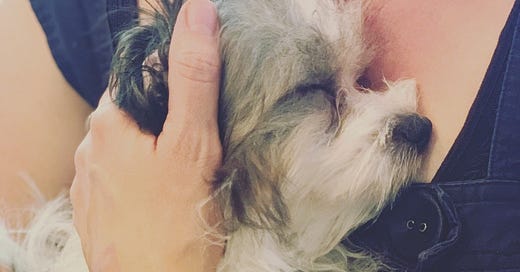🧵Thursday Thread: How Can We Listen Across Species?
If the world gives itself to our imaginations, the world's non-human animals are a huge part of that gift. Have you had a special experience/relationship with an animal, domestic or wild? Tell us!
The pic is me with Frannie, on her first day with our family back in 2019. She was about six months old then, and kind of a disaster, and I loved her instantly.
The next year, during the height of lockdown, I was asked to teach a writing class at Shakopee prison in Minnesota, and the women there requested that the class be on writing animals. I thought, heck, I don’t know anything about writing animals, but if that’s what these women want to learn about, then I will learn too.
Friends, I learned so much. Teaching that class made my writing (and life) so much better in so many ways. Not the least of which was due to studying the work of Alexis Pauline Gumbs, author of the magnificent, strange, and brilliant book, Undrowned: Black Feminist Lessons from Marine Animals. In that book, Gumbs asks:
How can we listen across species, across extinction, across harm? How does echolocation, the practice many marine mammals use to navigate the world through bouncing sounds, change our understandings of “vision” and visionary action?
Oof course, a lot of you already know how I feel about my beloved Frannie, and what she’s taught me already, what she keeps teaching me everyday.
It’s easy to take our pets for granted, in a way, since we take care of them. But one time, when Frannie—with her impossibly light body and gossamer hair— was very new to our family, Billie said, “Just think, Mom, how we’d feel if an animal like this wandered up to us in the forest, if an animal like this trusted us, and let us touch her and hold her?”
I think about that all the time now. Because ultimately, are we all not just animals, and wild, too, in our heart of hearts? Didn’t Mary Oliver say so, when she told us we could let the soft animal of our body love what it loves? And didn’t Brian Doyle suggest as much in his ecstatic essay, “Joyas Voladoras,” in which he wrote:
Mammals and birds have hearts with four chambers. Reptiles and turtles have hearts with three chambers. Fish have hearts with two chambers. Insects and mollusks have hearts with one chamber. Worms have hearts with one chamber, although they may have as many as eleven single-chambered hearts. Unicellular bacteria have no hearts at all; but even they have fluid eternally in motion, washing from one side of the cell to the other, swirling and whirling. No living being is without interior liquid motion. We all churn inside.
Anyway. Thank you all for an incredible (INCREDIBLE) Thread last Thursday on our relationships with our mothers. I’m filled with gratitude.
This week, let’s talk about our relationships with an animal or animals. I’ll meet you in the comments—and thank you so much for being here, listening through the “bouncing sounds” of each other’s lives.
Love,
Jeannine
PS Threads/comments are for paid members; you can upgrade/manage your membership here anytime.





